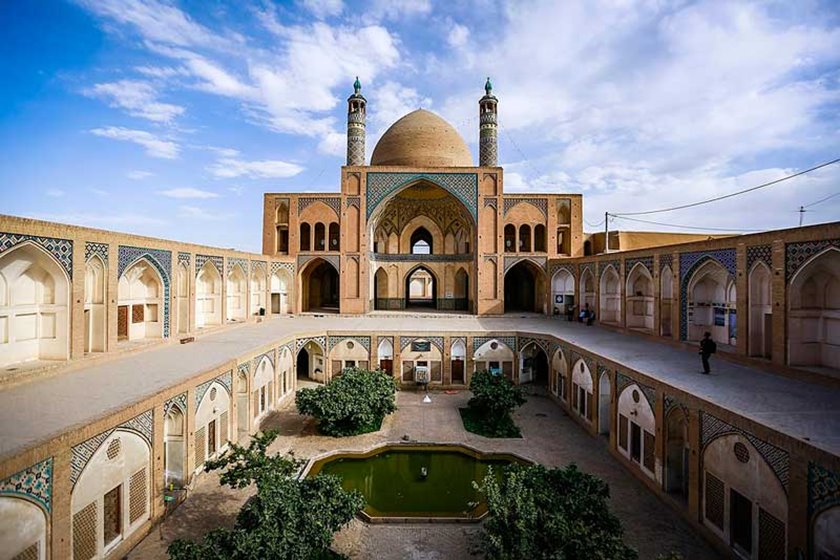Agha Bozor Mosque and School
Agha Bozor Mosque and School of Kashan is one of the most magnificent and beautiful mosques of the Qajar period in Iran.
This mosque was built with the capital of Haj Mohammad Taqi Khanban during the years 1250 to 1260 to hold congregational prayers and lectures of his son-in-law, Mulla Mahdi Naraghi II, the brother of Mullah Ahmad Naraghi, nicknamed Agha Bozor, on Fazel Naraghi Street in Kashan, within the historical and ancient context of this city. .
Finn’s garden and bath
Fin garden and bath complex in Kashan city is one of the most attractive and attractive places for Iranian and foreign tourists. The history of Fin Garden dates back to the Safavid period and its area is over 23 thousand square meters. This complex includes a central courtyard surrounded by walls, ramparts and towers.
Among the charms of Fin Garden, we can point out the old trees, amazing and regal architecture, and the Fin bath and the story hidden in it, which is related to Amir Kabir, the chancellor of the Qajar period. The architecture of this garden is a combination of natural elements such as water and trees and fixed elements such as different buildings.
Jalali Castle and Seljuk Wall
Next to the historical monuments of Kashan and in the center of the historical fabric of this city, there are two tall thatched walls, which are the remnants of the famous Seljuk fence. This impregnable fortress was built in the middle of the 5th century Hijri during the Seljuk government by Khwaja Majiduddin Abulqasem Kashani, who was a famous man of the Seljuk government. Authentic historical documents show that this high fortress has saved the people of Kashan from the brutal attack of the invaders several times.
Next to this fort stands out a huge castle that was built by order of Sultan Jalaluddin Malik Shah Seljuk. This mud and clay castle has been the stronghold and government center of Kashan for some time.
Silk Hill
The ancient site of Silk Hill is the first human civilization in the central part of Iran, which contains historical heritage such as the oldest hand-made clay. Silk is one of the historical places where written documents belonging to the pre-Achaemenid era have been found. Nearly 5,000 years ago, the cave-dwelling people of Iran moved to the plains due to climate changes and the formation of grasslands. The oldest people living in the plains were the people of the Silk area in Kashan.
The underground city of Nooshabad
The underground city of Noushabad belongs to the Sasanian period and is 1500 years old. This complex is built on 3 floors and is located at a depth of 4 to 18 meters and is in the form of a handrail. This collection was discovered by a man who was digging a well in his house. The underground city of Noushabad consists of a number of corridors, corridors, rooms and wells. This city has a completely military and strategic use, and it is full of ways to fight and deceive the enemy. This complex was used as a shelter when the attackers attacked.
Sultan Amir Ahmad bath
This bathroom is a unique example of Iranian bathrooms in terms of architecture and decorations. This bath was built in the Seljuk period and has an area of 1102 meters and has a complex and nested architecture. The roof of this bathroom is one of the symbolic places of Kashan and is the subject of many photographers.
French traveler Chardin says about Kashan baths: Kashan hot springs are excellent, good and clean.
Reservoirs
It is an indoor pond or pool that is usually built in the basement to store water. In the rainy seasons, the reservoirs are filled to be used in the rainy seasons. This structure has been of great importance in the cities of Kashan, Yazd, and Minab, as well as in the south of Fars and Hormozgan provinces.







